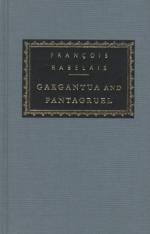The first sixteen chapters may, and really must be, the text of Rabelais, in the final form as left by him, and found after his death; the framework, and a number of the passages in the continuation, the best ones, of course, are his, but have been patched up and tampered with. Nothing can have been suppressed of what existed; it was evidently thought that everything should be admitted with the final revision; but the tone was changed, additions were made, and ‘improvements.’ Adapters are always strangely vain.
In the seventeenth century, the French printing-press, save for an edition issued at Troyes in 1613, gave up publishing Rabelais, and the work passed to foreign countries. Jean Fuet reprinted him at Antwerp in 1602. After the Amsterdam edition of 1659, where for the first time appears ’The Alphabet of the French Author,’ comes the Elzevire edition of 1663. The type, an imitation of what made the reputation of the little volumes of the Gryphes of Lyons, is charming, the printing is perfect, and the paper, which is French—the development of paper-making in Holland and England did not take place till after the Revocation of the Edict of Nantes—is excellent. They are pretty volumes to the eye, but, as in all the reprints of the seventeenth century, the text is full of faults and most untrustworthy.
France, through a representative in a foreign land, however, comes into line again in the beginning of the eighteenth century, and in a really serious fashion, thanks to the very considerable learning of a French refugee, Jacob Le Duchat, who died in 1748. He had a most thorough knowledge of the French prose-writers of the sixteenth century, and he made them accessible by his editions of the Quinze Joies du Mariage, of Henri Estienne, of Agrippa d’Aubigne, of L’Etoile, and of the Satyre Menippee. In 1711 he published an edition of Rabelais at Amsterdam, through Henry Bordesius, in five duodecimo volumes. The reprint in quarto which he issued in 1741, seven years before his death, is, with its engravings by Bernard Picot, a fine library edition. Le Duchat’s is the first of the critical editions. It takes account of differences in the texts, and begins to point out the variations. His very numerous notes are remarkable, and are still worthy of most serious consideration. He was the first to offer useful elucidations, and these have been repeated after him, and with good reason will continue to be so. The Abbe de Massy’s edition of 1752, also an Amsterdam production, has made use of Le Duchat’s but does not take its place. Finally, at the end of the century, Cazin printed Rabelais in his little volume, in 1782, and Bartiers issued two editions (of no importance) at Paris in 1782 and 1798. Fortunately the nineteenth century has occupied itself with the great ‘Satyrique’ in a more competent and useful fashion.




